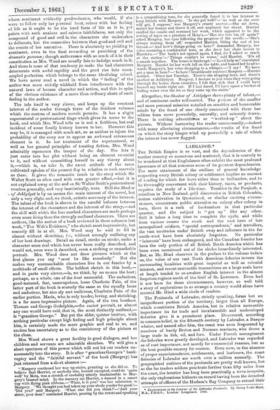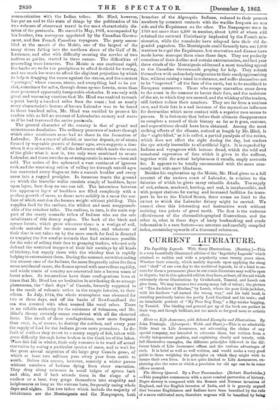LABRADOR. * THE British Empire is so vast, and the dependencies
of the mother country so numerous and scattered, that it is scarcely to be wondered at that Englishmen often exhibit the most profound ignorance of all that concerns some of its greatest•dependencies. The mere attainment of the outlines of general knowledge respecting every British colony or settlement implies an amount. of reading for which few have either time or inclination, and to be thoroughly conversant with their history, races, or products, requires the study of a life-time. Troubles in the Punjaub, rebellion in New Zealand, gold discoveries in British Columbia, cotton cultivation in Queensland, or similar exciting circum- stances, concentrate public attention on colony after colony in turn, there is a rush of bookmakers in that particular quarter, and the subject is " got up " like any other. Still it takes a long time to complete the cycle, and while from various causes the south and time east have of late monopolized soldiers, " special correspondents," and travellers,- the vast territories under British sway and influence in the far
north-west have been absolutely forgotten. No particular "interests" have been endangered, and the Canadian frontier has been the only portion of all British North America which has been even mentioned out of the circles immediately interested. But, as Mr. Hind observes in the preface to the volume before us, the value of our vast North American fisheries invests the surrounding localities with great imperial as well as colonial interest, and recent mercantile transactions on a large scale have at length tended to re-awaken English interest in the almost forgotten regions north of the Gulf of St. Lawrence. Even had it not been for these circumstances, however, so well told a story of explorations in so strange a country would alone have secured Mr. Hind a wide circle of readers.
The Peninsula of Labrador, strictly speaking, forms but an insignificant portion of the territory, larger than all Europe, which constitutes British America, but in relative mercantile importance its fur trade and inexhaustible and undeveloped fisheries give it a prominent place. Discovered, according to common belief, in the fifteenth century by Labrador, a Basque whaler, and named after him, the coast was soon frequented by numbers of hardy Breton and Norman mariners, who drove a large trade in fish, oil, and furs. Under French management the fisheries were greatly developed, and Labrador was regarded as of vast importance, not merely for commercial reasons, but as the best possible nursery for seamen. Even now, in the absence of proper superintendence, settlements, and harbours, the coast fisheries of Labrador are worth over a million annually. The geographical outlines of the peninsula are pretty well known, but as the fur traders seldom penetrate further than fifty miles from the coast, the interior has long been practically a terra incognita. the only explorations hitherto on record having been the detached attempts of officers of the Hudson's Bay Company to extend their communication with the Indian tribes. Mr. Hind, however, has put an end to this state of things by the publication of his two volumes of observant travel in the most characteristic dis- tricts of the peninsula. He started in May, 1881, accompanied by his brother, two surveyors appointed by the Canadian Govern- ment, and five French Canadian voyageurs. The party assem- bled at the mouth of the Moisie, one of the largest of the many rivers falling into the northern shore of the Gulf of St. Lawrence, and after with difficulty securing the service of two natives as guides, started in three canoes. The difficulties of proceeding were immense. The Moisie is one continual rapid, the banks are rocks too precipitous to afford foothold for towing, and too much ice-worn to afford the slightest projection by which to help in dragging the canoe against the stream, and the constant " portages," where canoes, stores, and everything had to be car ried, sometimes for miles, through dense spruce forests, more than once presented apparently insuperable obstacles. It was only with great and unceasing exertion that Mr. Hind was enabled to reach a point barely a hundred miles from the coast ; but as nearly every characteristic feature of known Labrador was to be found in those hundred miles, Mr. Hind was enabled to present his readers with as full an account of Labradorian scenery and races as if he had traversed the entire peninsula.
The general character of the country is that of grand and monotonous desolation. The ordinary processes of nature through which other continents arose had no share in the formation of Labrador. Not a trace of alluvial, or marine deposit, or of strata formed by vegetable growth of former ages, even suggests a time when it was otherwise. Of all the influences which made the crust of the globe what it now is, two only were combined to create Labrador, and those two the most antagonistic in nature—heat and cold. The action of fire upheaved a vast continent of igneous rock, and the unceasing action of rolling ice through untold ages has converted every fragment into a smooth boulder and every mass into a rugged precipice. In immense tracts the ground on which the traveller walks consists simply of boulders, layer upon layer, how deep no one can tell. The interstices between the uppermost layer of boulders are filled completely with a profuse growth of moss, so dense as to solidify in a mass the sur- face of which sustains the human weight without yielding. This supplies food for the caribou, the wildest and most unapproach- able of the reindeer tribe. The caribou, in turn, is the main sup- port of the scanty nomadic tribes of Indians who are the solo inhabitants of this dreary region. The bark of the birch and spruce forests, which grow wherever there is a vestige of soil, affords material for their canoes and huts, and whatever of their time is not taken up by the mere search for food is directed to trapping the few smaller animals that find existence possible for the sake of selling their furs to grasping traders, who not only defraud the wretched trappers of their fair earnings by all kinds of trickery, but supply them with the whiskey that is rapidly helping to exterminate them. During the summer, notwithstanding the utmost care of the Indians, the moss frequently takes fire from some accidental cause, the flames spread with marvellous rapidity, and whole tracts of country are converted into a barren waste of burnt ashes. So tremendous have these conflagrations been at times that Mr. Hind has no hesitation in attributing those strange phenomena, the " dark days " of Canada, formerly supposed to be the result of volcanic action in the remote interior, to their effects. In July, 1814, the whole atmosphere was obscured for two or three days, and off the banks 9f Newfoundland the sea was covered with what seemed like wood ashes. There is no reliable authority for the existence of volcanoes, and Mr. Hind's theory certainly seems consistent with. all the observed facts. The result of these conflagrations, now more frequent than ever, is, of course, to destroy the caribou, and every year the supply of food for the Indians grows more precarious. In de- fault of caribou they resort to a scanty supply of fish, taken with great difficulty through holes broken in the thick ice of the lakes. When fish fail in winter, their only resource is to ward off actual starvation by eating a particular species of moss, and to wait for the great annual migration of the large grey Canada geese, of which at least two millions pass every year from north to south. Before this occurs, however, scarcely a winter passes without numbers of Indians dying from sheer starvation. They drag along existence in small lodges of spruce bark and skin, and if luck attends them in the shape of a caribou or a bear, they gorge themselves into stupidity and helplessness as long as the carcase lasts, frequently eating whole days and nights. The two tribes which include the majority of inhabitants are the Montaignais and the Nasquapees, both
branches of the Algonquin Indians, reduced to their present numbers by constant contests with the warlike Iroquois on one side and the Esquimaux on the other. The Nasquapees were in 1858 not more than 2,500 in number, about 1,000 of whom still retained the outward Christianity implanted by the French mis- sionaries, while the remainder have relapsed into their old de- graded paganism. The Montaignais could formerly turn out 1,000 warriors to repel the Esquimaux, but starvation and disease have made havoc amongst them since those days. They are perfectly conscious of their decline and certain extermination, and last year three chiefs of the Montaignais addressed a most touching appeal to the Canadian Government praying for help. They submit themselves with melancholy resignation to their surelyapproaching fate, without raising a hand in resistance, and suffer themselves not to be "improved" off the face of the earth, but to be sacrificed to European commerce. Those who escape starvation come down to the coast in the summer to barter their furs, and the moisture of the air, to which they are unused, and the whiskey of the traders, still further reduce their numbers. They are far from a noxious race, and their fate is a sad instance of the mysterious influence for destruction which mere contact with a superior race seems to possess. It is fortunate that before their ultimate disappearance so complete a record of their history as far as it goes, customs, and superstitions should have been obtained. Among the most striking effects of the climate, noticed at length by Mr. Hind, is the " night-blind," as it is called, a partial paralysis of the retina, which does not affect the sight during the day, but renders the eye utterly insensible to all artificial light. It is regarded by Indians and voyageurs with intense dread, which the wild and unnatural expression of face which it gives to the sufferer, together with the actual helplessness it entails, amply accounts for. It appears to be totally unconnected with the more com- monly met with snow blindness.
Besides his exploration up the Moisie, Mr. Hind gives us a full account of the eastern coast of Labrador, in relation to the fisheries of which he gives many valuable details. The supply of cod, salmon, mackerel, herring, and seal, is inexhaustible, and with proper stations for curing and increased facilities for trans- port in ice to the United States, there seems no limit to the extent to which the Labrador fishery might be carried. We cannot close this interesting and instructive work without noticing two points of great merit. The first is the extreme effectiveness of the chromolithographed illustrations, and the other is, what in these days of hasty bookmaking and crude information is a rare feature—au accurate and carefully compiled index, containing upwards of a thousand references.































 Previous page
Previous page